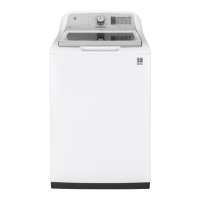
Do you have a question about the GE GTW750CPLDG and is the answer not in the manual?
General safety notice for service personnel regarding experience and potential hazards.
Warning to disconnect power before servicing to avoid personal injury.
Instruction to ensure all grounding devices are properly reconnected after service.
Required safety gear for GE Factory Service employees during repairs.
Mandatory 6-step process for safely servicing the appliance before disassembly.
Explanation of the letters and numbers that comprise the model number.
Details on how to identify the manufacturing month and year from the serial number.
Highlights key features of the GE 27 Inch Top Load Washer.
Diagram and explanation of the control panel buttons and indicators.
How to use the Power and Start/Pause buttons for cycle operation.
Explanation of display messages and status lights during cycles.
Details for Cycles like Colors, Casuals, Delicates, Active Wear, and Cold Wash.
Details for Speed Wash, Basket Clean, Sanitize With Oxi, Jeans, and Heavy Duty cycles.
Guidance for washing Bulky Items, Towels, Sheets, and Whites.
Important cautions for washing waterproof, water-resistant, or bulky items.
Deep Fill and Warm Rinse options for wash cycles.
Auto Soak and Delay Wash options for cycle customization.
Deep Rinse and Extra Rinse options for improved cleaning.
How to store and recall custom wash cycle settings.
How to lock and unlock washer controls to prevent changes.
How the SmartDispense feature automatically adds detergent.
Manually selecting detergent amount for specific loads.
Common display messages and their simple remedies.
Explanation of the washer's redistribution process for out-of-balance loads.
AC/DC voltage requirements and resistance values for components.
Approximate minimum and maximum water levels for impeller models.
Diagram identifying parts located on the underside of the top cover.
Exploded view of the tub assembly and its related parts.
Exploded view of the backsplash assembly.
Identification of connectors on the electronic control board.
Diagram of components visible from the bottom of the washer.
Procedure to enter/exit CEM for retrieving fault codes.
Procedure to enter/exit Field Service Mode for testing.
Tests for LEDs, Fault Codes, Personality ID, and Software Versions.
Tests for valves, pumps, motor functions, and pressure sensor.
Tests for Lid Switch, Spin, Agitate, and clearing fault codes.
Procedure to access and view logged fault codes in service mode.
Repair actions for Lock Monitor, Lid Monitor, Rotor Monitor, and Reset Monitor faults.
Repair actions for Pressure Sensor, Flood Level, and Lid Switch faults.
Repair actions for Mode Shifter, Motor, Drain Pump, and Water Temp faults.
Procedure to change or verify the washer's personality ID.
Step-by-step instructions for removing the backsplash assembly.
Steps to remove the glass lid from the washer.
Procedure for removing and reinstalling the lid latch mechanism.
How to diagnose the lid lock mechanism's operation and resistance.
Steps to remove the bezel and the lid switch/lock assembly.
Steps to remove the lid hinges without removing the top cover.
Steps to remove the impeller, including bolt replacement advice.
Steps to remove the top cover assembly.
Steps to remove the wash basket from the tub.
Instructions for removing the cabinet/apron assembly, noting weight and size.
Procedure for adjusting leveling legs to ensure the washer is level.
Location of the water valve and how to diagnose its coils.
Steps to remove the four-coil water valve assembly.
Description and resistance table for the thermistor.
Steps to remove the bleach/bulk tank funnel.
Description of the dispenser box and its limitations.
Methods for supporting the top cover during service.
Detailed steps for removing the dispenser box.
Information on tank capacity and dispensed detergent amounts.
Steps to remove the bulk detergent tank from the top cover.
Explanation of the aspirator's function and steps for removal.
Minimum and maximum water levels for impeller models.
Explanation of the water saver rinse process and logic.
Purpose, replacement, and testing of the pressure sensor.
Description of the recirculation pump's role in spraying water.
Steps to remove the recirculation pump from the tub.
Description of the drain pump's function and specifications.
Steps to remove the drain pump from the tub.
Steps to remove the internal drain hose.
Steps to remove the external drain hose.
Description of the drive belt and its installation process.
Description and removal procedure for drive and transmission pulleys.
How the sensor works and how to diagnose its operation.
Steps to disconnect and remove the speed/hall sensor.
Motor power, belt type, and diagnostic resistance values.
Steps to remove the drive motor from the platform.
Description of the mode shifter, its diagnosis, and removal.
Description of the platform assembly housing the transmission.
Steps to remove the platform/transmission assembly.
How the main harness supplies power and signals to components.
Steps to remove the main harness assembly.
Description of the riser and steps for its removal.
Table of component resistances for diagnostic purposes.
Key to wire colors used in the schematics and diagrams.